Dialed In by Jersey Jack Pinball
Let me start with saying that I really love this game. When starting to write this review and thinking about why I love it, I realised it’s difficult to explain. This game is good (or even great) but it could’ve been sooo much better.
Anyway, Dialed In. Released in 2017, the third game by JJP, after Wizard of Oz and The Hobbit. Designed by Pat Lawlor, the man who brought us
timeless classics like The Addams Family, Twilight Zone, Funhouse and many more. After Williams stopping the pinball division, Pat had worked
at Stern Pinball until the economic crash in 2008.
Starting at JJP was (again) a bit of a comeback to pinball for him. Rumour goes that Jack had given Pat carte blanche, to let him design
the game he really wanted to make and not be limited by budget constraints.
Pat and the group at JJP came up with a playfield layout and total package that is amazing. This game is packed with features. It’s a regular body playfield, but it has so many shots and toys, it could’ve been a widebody game. Many ramps, 5 magnets, 3 flippers, 2 screens on the playfield, and much more.
There are a lot of elements taken from other games, and they are all integrated so well. The skillshot is at the back of the playfield, similar to shooting behind Rudy’s head on Funhouse. The third upper flipper is also something that’s in a lot of Pats designs. The flow of this game is just so smooth, you can shoot ramps and orbits all day long. The ramps and the concept of travelling reminds me of Road Show. There’s a magnet that stops and shoots the pinball up, like in The Shadow. There are magnets hidden under the playfield like on The Addams Family. There’s a trapdoor hidden on the left orbit, a mechanism used on Funhouse. There’s a physical 3 ball lock mechanism on the left side. The two lines of inserts towards the flippers were seen before on Pat's prototype of Wizard Blocks. The quantum reality theatre is the Pinball 2000 concept in smaller size: a screen on top reflects onto a clear plastic, one time you can see the ball pass underneath it, the other time you see the animations that are played. Because of the magnet underneath that can stop and even hold the pinball and fling it back up, shooting virtual drop targets actually feel like shooting the physical targets.
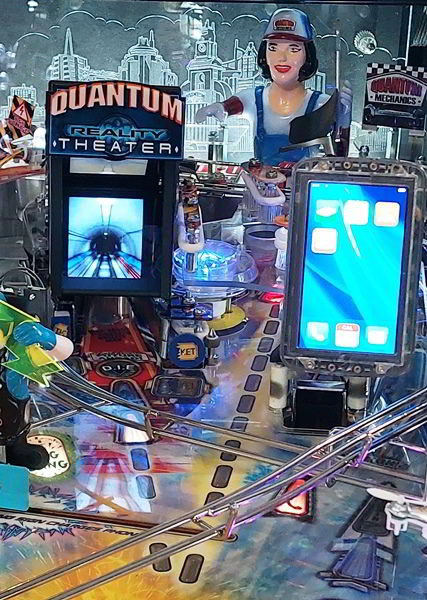
Diverter and the 2 screens.
The software also has a lot of references to other games. On the small display for example, you can see the rocket and gumball machine from Twilight Zone, or tokens from Safe Cracker. The female voice you hear (Mandy) is the same voice as Candy on Safe Cracker. Crazy Bob is also a character seen on other WPC games (like Junk Yard). Some modes are named after Pat's early machines: Whirlwind and Earthshaker. You can repeat shots on the main ramp for increasing points, similar as you do on Whirlwind.
If you’ve played many of the popular WPC games, especially those designed by Pat, this game will instantly feel familiar.
Other mechanisms are a moving target (similar to Dracula on Monster Bash) and a diverter on the ramp in the back. 2 small lcd displays on the playfield, which really are well integrated in gameplay. There are 3 real mini drones. A camera that takes your picture during selfie mode, and in another mode you have to wave your hand at it (and risk draining the ball). This game has so many features and mechanisms on the playfield, you could say it’s Pat’s new Twilight Zone. It’ll take a long time until someone will again release a game with so many playfield features and where the theme is so well integrated together.
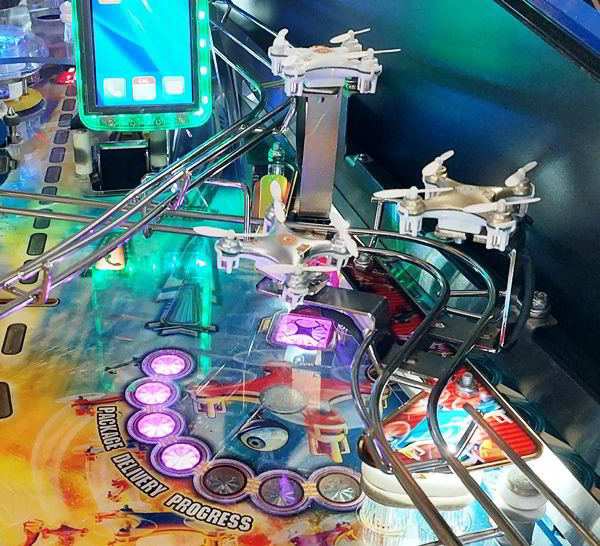
Real drones on the playfield.
But now, the theme. Dialed In is an original theme. People say for years they want original themes, but don’t want to admit that it’s licensed games that sell. There’s been a lot of discussion if this is a cell phone game or not. It’s a cell phone game, it’s a disaster theme, it’s a Sim City-like theme, .. Whatever your opinion is: the theme is an inconsistent mess, and probably the reason why this great layout doesn’t get the love it deserves.
The story is explained in the comic book that comes with the game and in the animations when you’re not playing. You buy a new phone that you shouldn’t have received. It’s a special prototype, created by an evil company that wants to destroy a city. You have to stop them. Or something like that. Maybe you also start the disasters? I’m still not sure. This futuristic world is getting destroyed by disasters and your cell phone can do something about them.
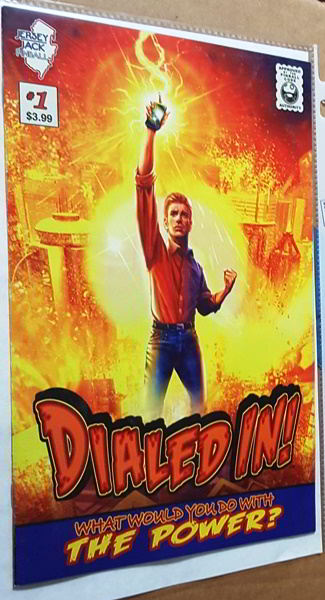
The comic book that starts the story.
The main goal of the game is to start and complete timed disaster modes. Hit the moving target a few times and then get the pinball into the cell phone scoop to start a disaster. The available disaster modes are represented as apps on the phone screen. Disasters link this game to Pat’s previous disaster themed games: Earthshaker and Whirlwind.
There are many different modes. Some are easy, some are more difficult. For each mode you have to make a few shots in time. All parts of the playfield are used by the different modes, there’s enough variance in the shots you have to make for each mode. Finish a mode in time, and a sim card upgrade is lit at a scoop to collect.
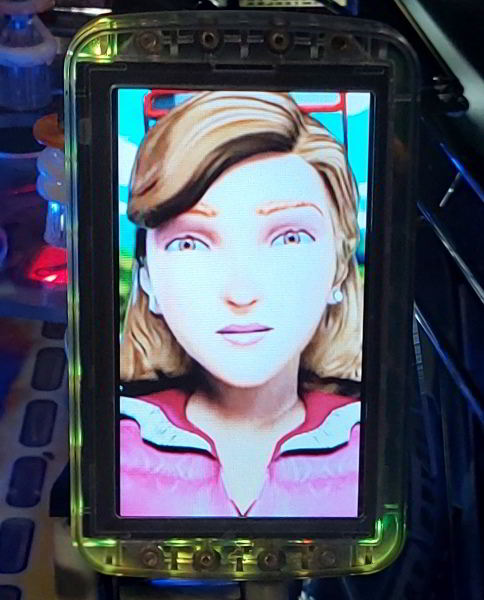
Each disaster mode has their own animated persona.
They give you instructions or comments.
This is where the big points are in this game. Consecutive modes will score higher the more sim cards you have collected. To score high points on this game (and work towards the disappointing wizard mode), you have to complete all disaster modes and collect all sim cards. That’s it, a similar gameplay to TZ or TAF, where you have to play all modes.
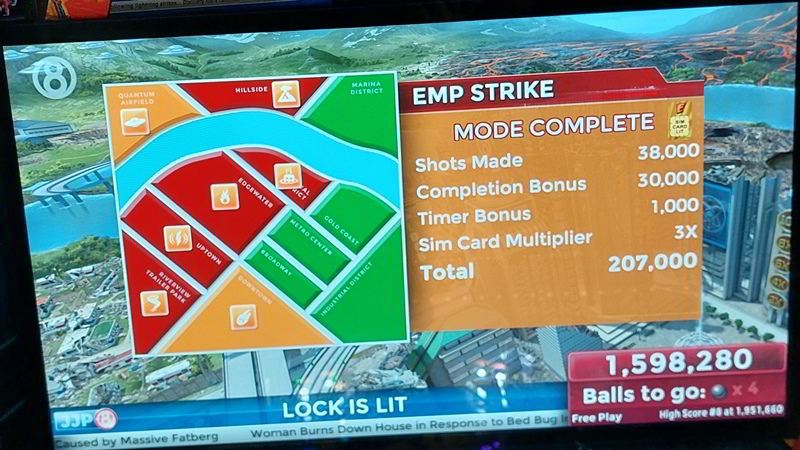
Overview of played (orange) and completed (red) disaster modes.
Some people say Dialed In is similar to a WPC game, just made 20 years later with new technology. Gameplay is simple to understand: just play all timed modes. Old-fashioned pinball, no complicated rules with many layers and stacking like we’re used to seeing in the last decade.
To keep things entertaining and not too linear, there are other things to go for. You can lock 3 balls to start a multiball.
You can start side modes (random Bob awards) which can also award some quick multiballs.
There’s a multiball mode in which you have to hit the moving target for the jackpot. In another multiball mode you have to sneak a pinball past
the moving diverter on the centre ramp to score a jackpot.
Shoot enough drones or other parts on the playfield, collect kilowatt power (‘the power’ is also a theme found in Pat’s other games).
In the quantum theatre you can hit virtual targets, such as virtual drop targets, spinners, train doors and collect coins.
Complete those four parts and quantum mania multiball will start.
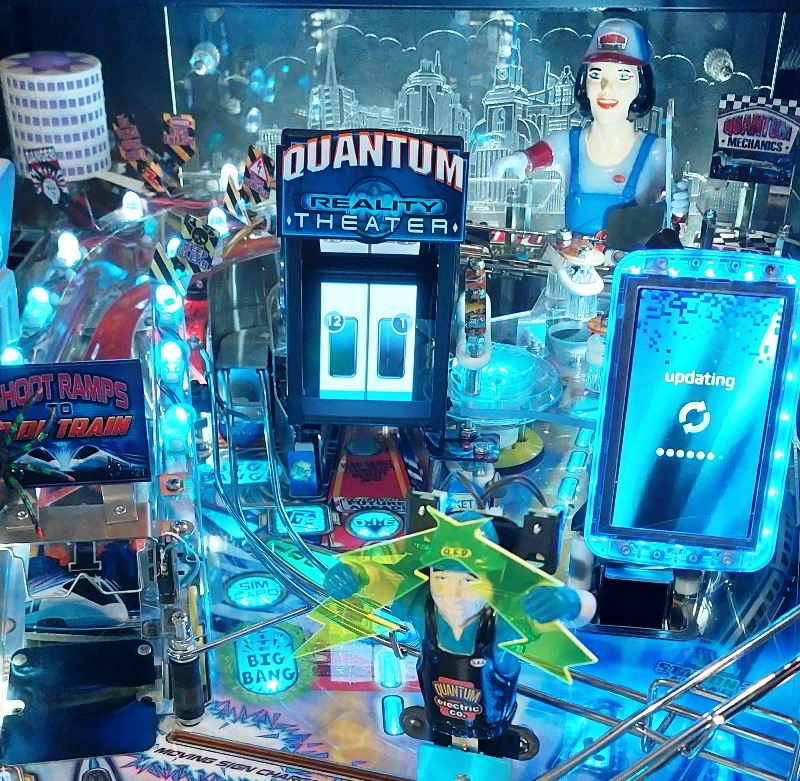
Shoot the virtual train doors.
When you’re under attack during a multiball, the row of inserts towards each insert will be lit. If it reaches your flipper, that flipper will vibrate a bit and have less power for a few seconds. You can hit a target to stop this progress. One of the multiballs is an add-a-ball, shoot the phone scoop 3 times to add another ball to the multiball.
On paper, all of these different multiballs and modes sound great. In reality I find they give less variation than you’d expect. Maybe it’s because of the way I play (I try to work on the disaster modes), but usually after a few sim cards, multiballs just happen suddenly and usually a few stack together. It’s nice that everything suddenly scores jackpots, but it can be confusing to know what exactly is running and why it started. And when the furious multiball session is over, it's back to disaster modes again.
How multiball and jackpots are integrated in this game is a major change from how you’re used with other Pat Lawlor games. Usually you have to work to lock balls and start a multiball. Scoring a jackpot on Twilight Zone or Addams Family, or even on Whirlwind or Funhouse, is a great achievement. It’s one of the goals of the game. Starting a multiball is one thing, being able to score a jackpot is another. When you do, the game will make sure you'll notice - it will impress you with the big lights and an explosion of sounds. It’ll award a lot of points.
Unfortunately, there couldn’t be a bigger difference with Dialed In. Forget about jackpots. They’re much easier to shoot, the sound effects are so bland and boring that the game seems unimpressed you scored a jackpot. Jackpots score a low amount of points, going for multiball and jackpots (or the side modes) are not a strategy that will earn you a place on the high score list.
Not only the jackpot sounds, but most of the sound effects on this game are uninspired. That’s the atmosphere they go for. While they say funny things and there are many samples, their tone is not exciting at all. This is also something in which this game lacks and which doesn’t help the first impression new players get.
Like all JJP games, the rendered animations on the screens are of an outstanding quality. They are amazing, and there are many. The level of detail is high. A multiplier for instance is part of the facade of one of the buildings and will light up depending on your gameplay. The animations also change depending on the modes you've played. All modes and playfield mechanisms are presented as buildings in the city. Their animations change depending on how you play and interact with them.
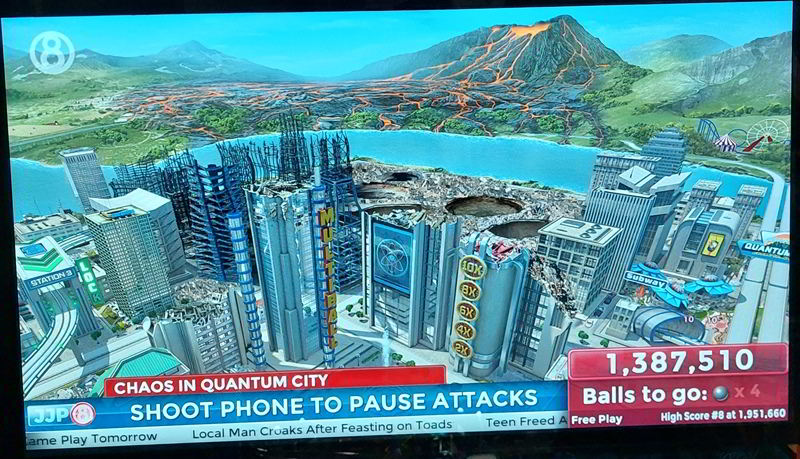
A volcano and a rollercoaster in the back.
On the forground the multiball, multiplier and quantum theatre buildings. On the left you see the transtation. It's animated to
indicated the player can lock a pinball.
Overall, some parts of the animations are less obvious and not helping the storyline. During modes the city will be destroyed, and you have to stop this. Complete the alien invasion mode and the flying saucers are parked on the grass. That seems the only mode where something ‘good’ happens when you finish a mode. With all other modes, it seems the more modes you play, the more the city gets destroyed. In meteor mode for example, the goal is to hit enough standup targets to win the mode. But each target hit will display on the playfield as a meteor strike that destroys part of a building? It doesn’t help the story that while playing you have to save the city, when you only see the city get destroyed more in the animations. Or is the story that you as a player want to destroy the city and the game wants to stop you? If that's the storyline, why would you do that? Who'd want the player to destroy things whilst playing?
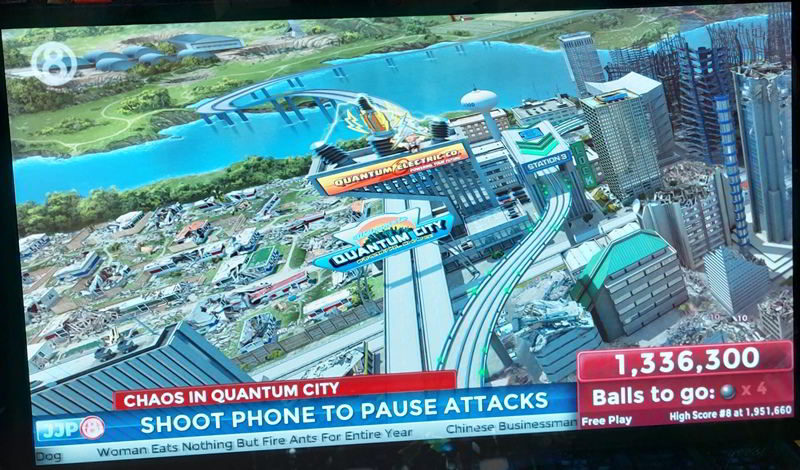
A lot of modes are played: the airport in the back was attacked by aliens
and the trailer park on the left is destroyed by a whirlwind.
There are other things in the game that don’t make sense. There’s a spider. A D-Bug building in the animations, a spider plastic on the centre ramp, and then virtual spider target you have to shoot in the quantum theatre. What’s the link between spiders and city disasters? It seems to come from an early idea the crew had. The player would be a computer programmer who found bugs. They changed the story that you bought a cellphone, but some bug and spider references remained.
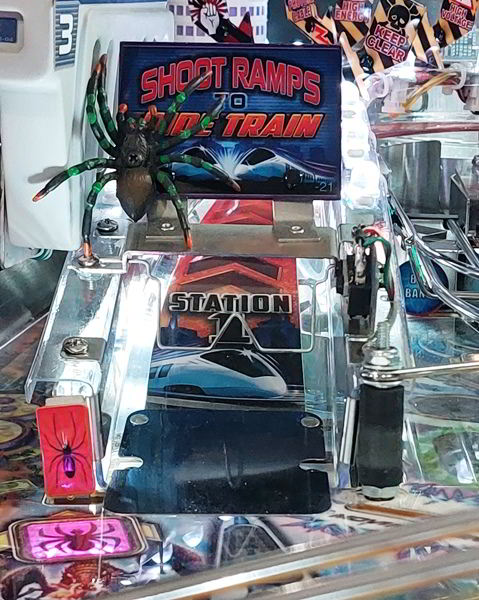
Spiders everywhere
The mechanic diverter in the back is similar. There’s a female figure in the back. Her arm is a diverter that can divert the pinball onto a mini playfield and into the pop bumper area: the workshop. So you’d think you need to get enough pop bumper hits to repair or build up something? Does the mechanic or you work on cars (which you almost never see on the roads in the animations) or on the train? No, nothing of this all. Pop bumpers just score points, nothing more. Why there’s a mechanic and how this ties into the storyline, remains a mystery.
The same can be said about the cellphone. This game probably would’ve been much better when it was themed as a pure disaster game. A cellphone that stops disasters? That you need new sim cards for? A selfie mode? Just imagine it’s not a standard cellphone, but some kind of futuristic communication device.
The drones at least somehow tie into the story. They’re used in this futuristic city to deliver packages. Collect them for extra points or bonuses.
Some parts just don’t make sense and make the total theme more confusing. Dialed In is an excellent game with nice graphics, just try to play it and not think too much about it.
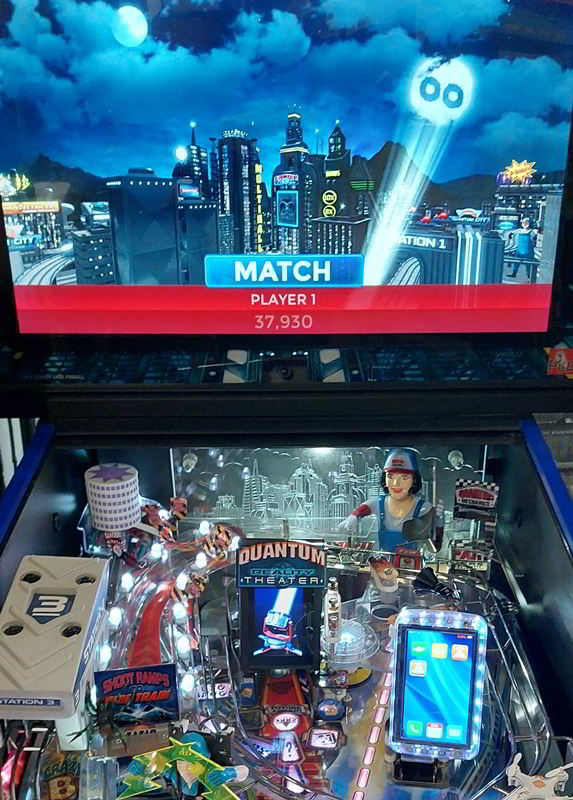
Even the match sequence is amazingly detailed. Don't ask me how
they do it, but the rgb lights really simulate it becoming night and the playfield goes dark.
The spotlight (displayed on the theatre screen) moves around, its lightbeam extends over the backpanel lightning onto the main playfield.
The game was created in 3 versions: Standard, Limited and Collector's Edition. Compared to SE, the LE version added a shaker motor, anti reflective playfield glass, rgb leds on the center ramp and an etched and lit panel on the back of the playfield. The SE edition had a camera flash unit on top of the playfield, to help make well lit photos. The other games don't need that unit.
When the game was new, phone interaction was a feature of it. The pinball machine has a Bluetooth dongle installed. There was a phone app from JJP for Dialed In available. You could connect the pinball machine to your phone. This allowed the player to control the flippers, which was more of a gimmick, but also to active the big bang shot that would end a mode, from your phone, without having to shoot a target. Some people couldn't get it working on their phone, and about 2 years later JJP dropped support for the app.
In 2022 JJP then came with a new update. One could buy a wifi dongle (and unplug the Bluetooth dongle that wasn't used anymore) to connect the game to wifi.
JJP advises to buy a TP-Link Nano Wifi dongle.
It can be used for updates, now there's no need anymore to download files from your computer on and copy them onto an usb stick for that.
More important: this wifi dongle enabled integration with the Scorbit platform.
This was an amazing upgrade! There really was an added value for players: one could keep track of highscores and gain achievements in the game.
Unfortunately, again, a good year later JJP dropped all support for Scorbit suddenly without any communication.
Fortunately it's still possible to have Scorbit on your game, for this you should not upgrade to the latest version and contact Scorbit to whitelist your home
ip-address.
Oh, the irony. Owners of the once most advanced high tech game about cell phones and being connected, have only 5 years later 2 obsolete dongles and no online integration anymore. Not that I'm bitter and will never buy a JJP game anymore..
Whilst post-covid the value of most other pinball machines has sky rocketed, and most command even more than their original NIB price, Dialed In remained an exception. Probably because of all of these negative things I mention. This means Dialed has become a bargain. If you can look past the bad storyline, and want to have a great shooting game with cool mechanisms, with some nostalgic references to WPC games, DI really offers a lot of value for the money.
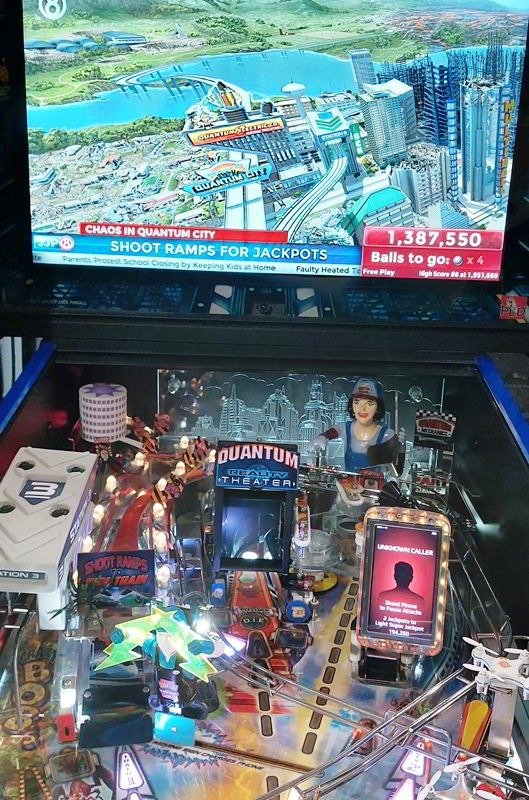
The electric company target on the main screen will move along with
the target on the playfield.
Things to look for when buying
Check when it was made. Early versions didn't have a protector on the phone scoop. Then JJP installed their own protector, and finally they switched to an improved Cliffy type of protector. Later versions also has a clear plastic on the left slingshot to keep the ball from falling off at the end of the ramp. Finally, later versions came with a thick (300 pages) manual. Owners of older games could buy it. You would want a later run version with the manual and protectors.
Check all mechanisms work, especially the rgb leds and small screens. The small screens can be bougt on aliexpress.
Check the drones work. Motors would wear out soon. One of the software updates changed when the game activates the drones. They hardly spin anymore during gameplay, to make the motors last longer. They are real drones, replacement motors are also available from other sellers.
Check all game specific parts work. JJP sold a lot of their inventory of spare parts, even plastic sets. If something breaks, you may not be able to order it from JJP anymore.
A small thing to check, not really important when buying or adding to the value, but more nice to know: some games are autographed by Jack, the company owner, on the backside of the backbox.
The game runs on pc hardware. There is a security dongle present in each game, this decrypts the game files (video and audio).
The bios of the motherboard has a password set. This password is: qmodem You may need this password whenyou change the battery.
Take care when you open the coin door and want to slide the playfield glass out of the game. The corner of the coindoor will slightly touch the playfield glass, which is easily scratched. Always close and lock the coindoor again after removing the lockdown bar, before you slide the glass in or out!

My Game
When Dialed In was released in 2017, I wasn’t much into pinball. I was burned out. I still followed the pinball scene from a distance. I knew there was a new game by JJP, but hadn’t bothered to research it, view pictures or gameplay movies. Even at the Dutch Pinball Open 2017 in Eindhoven where the game could be played (and spare playfields were for sale), I didn’t bother to look at it or play it.
It was only a year later when I visited a friend who had a Dialed In, that I saw and played the game for the first time. I only played 2 games but I was sold. This game was so amazing. All the mechanisms, the light shows, the quality of the animations, the whole integration of it all. Compared to other pinball machines at that time, usage of rgb leds by JJP is just amazing. Colors sweep smoothly over the playfield, or they’re aligned with voice samples. The toys, the smooth flow of the game, everything in this game felt special and amazed me. The animations, sounds, it’s a complete package that’s dialled in.
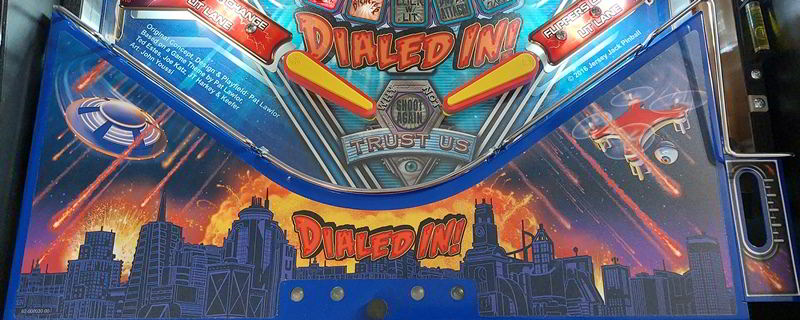
The instruction cards can be removed, revealing the full artwork on the apron.
A few days later I visited another friend who also had one and played more games on it. This convinced me to buy one myself. I had an Earthshaker and Whirlwind at that time, which planned to restore. Instead I decided to sell them (and a few other games) and get a Dialed In instead. And all these years later, I still love this game and am glad I bought it.
Click here to see the IPDB entry of this game.
If you're looking for pinball parts, then check out Pinballshop.nl (affiliate link).
